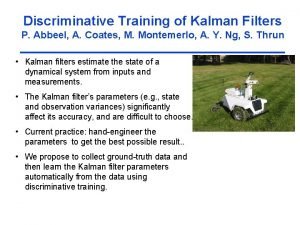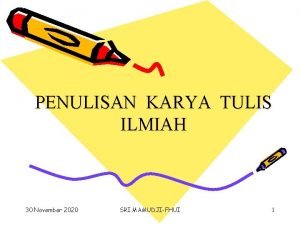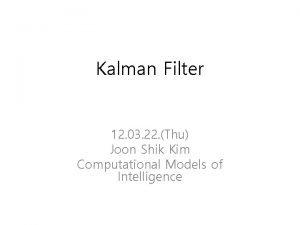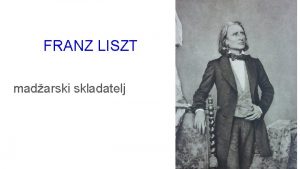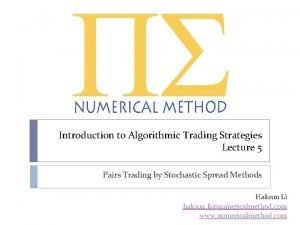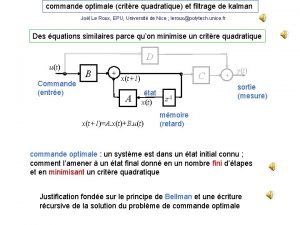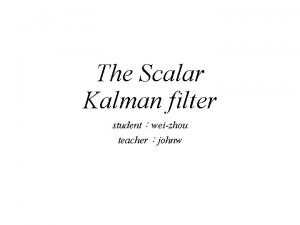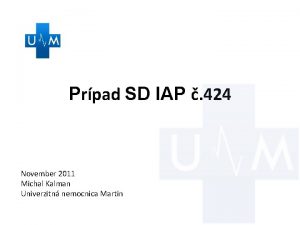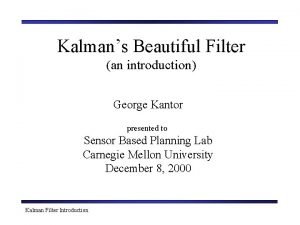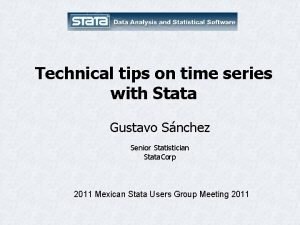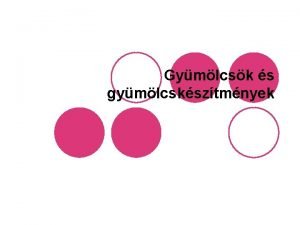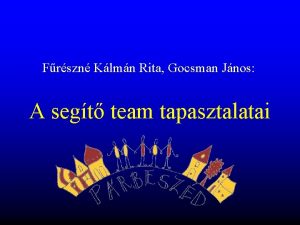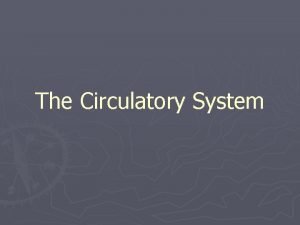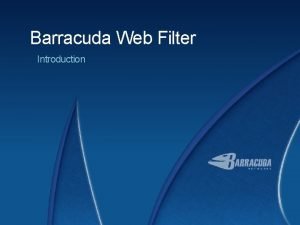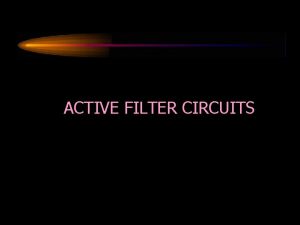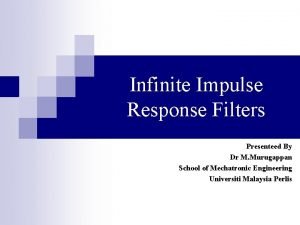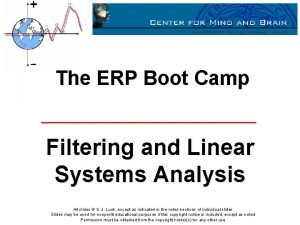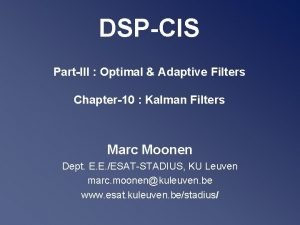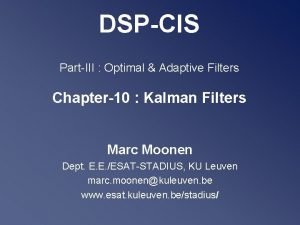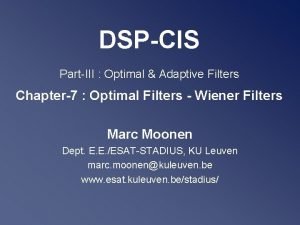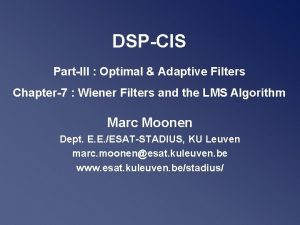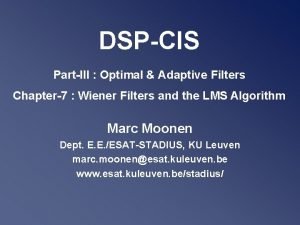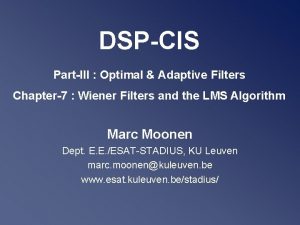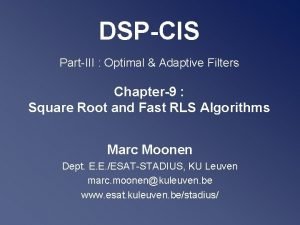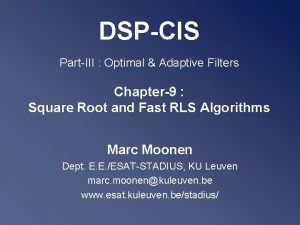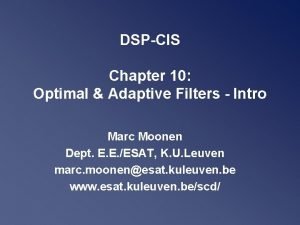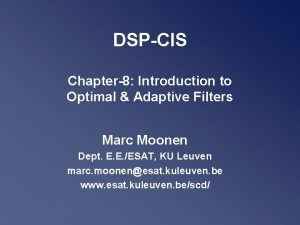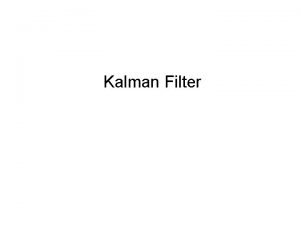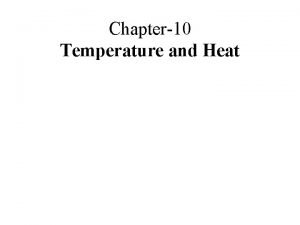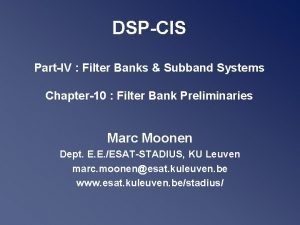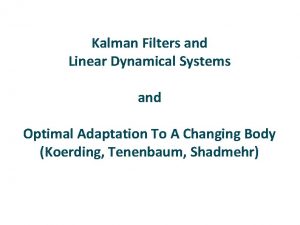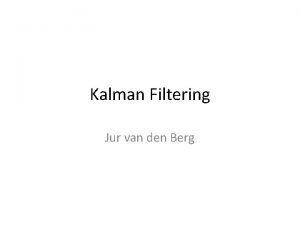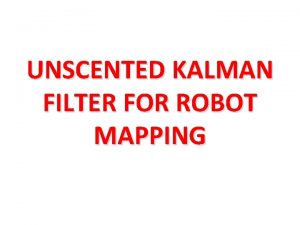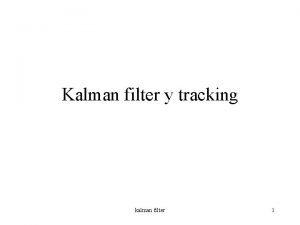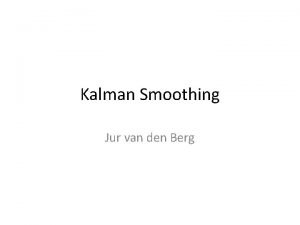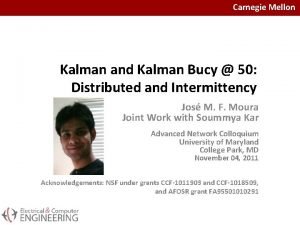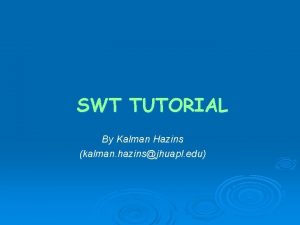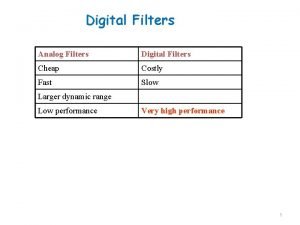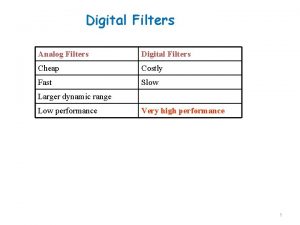DSPCIS PartIII Optimal Adaptive Filters Chapter10 Kalman Filters










![Kalman Filter Basics • Example: IIR filter u[k] + + -a 1 State space Kalman Filter Basics • Example: IIR filter u[k] + + -a 1 State space](https://slidetodoc.com/presentation_image_h/2c1738377b74f3f4aec38d2e0269bc73/image-11.jpg)














- Slides: 25

DSP-CIS Part-III : Optimal & Adaptive Filters Chapter-10 : Kalman Filters Marc Moonen Dept. E. E. /ESAT-STADIUS, KU Leuven marc. moonen@kuleuven. be www. esat. kuleuven. be/stadius/

Part-III : Optimal & Adaptive Filters Chapter-7 Optimal Filters - Wiener Filters • Introduction : General Set-Up & Applications • Wiener Filters Chapter-8 Adaptive Filters - LMS & RLS • Least Means Squares (LMS) Algorithm • Recursive Least Squares (RLS) Algorithm Chapter-9 Square Root & Fast RLS Algorithms • Square Root Algorithms • Fast Algorithms Chapter-10 Kalman Filters • Introduction – Least Squares Parameter Estimation • Kalman Filter Basics • Kalman Filter Algorithms DSP-CIS 2020 -2021 / Chapter-10: Kalman Filters 2 / 25

Introduction: Least Squares Parameter Estimation In Chapter-9, have introduced ‘Least Squares’ estimation as an alternative (=based on observed data/signal samples) to optimal filter design (=based on statistical information)… DSP-CIS 2020 -2021 / Chapter-10: Kalman Filters 3 / 25

Introduction: Least Squares Parameter Estimation ‘Least Squares’ approach is also used in parameter estimation in a linear regression model, where the problem statement is as follows… Given… k vectors of input variables (=‘regressors’) k corresponding observations of a dependent variable and assume a linear regression/observation model = where w 0 is an unknown parameter vector (=‘regression coefficients’) and e is unknown additive observation/measurement noise (see p. 3 for definition of U and d) Then the aim is to estimate wo Q: Can Least Squares (LS) estimate be reused here? DSP-CIS 2020 -2021 / Chapter-10: Kalman Filters 4 / 25

Introduction: Least Squares Parameter Estimation • If the input variables ul are given/fixed (*) and the additive noise e is a random vector with zero-mean the LS estimate is ‘unbiased’ i. e. • If in addition the noise e has unit covariance matrix then the (estimation) error covariance matrix is ✪ (*) Input variables can also be random variables, possibly correlated with the additive noise, etc. . . Also regression coefficients can be random variables, etc…etc. . . All this not considered here. DSP-CIS 2020 -2021 / Chapter-10: Kalman Filters 5 / 25

Introduction: Least Squares Parameter Estimation • The Mean Squared Error (MSE) of the estimation is defined as PS: This MSE is different from the one in Chapter-7, check formulas • Under the given assumptions, it is shown that amongst all linear estimators, i. e. estimators of the form (=linear function of d) the LS estimator (with Z=(UTU)-1 UT and z=0) mimimizes the MSE i. e. it is the Linear Minimum MSE (MMSE) estimator • Under the given assumptions, if furthermore e is a Gaussian distributed random vector, it is shown that the LS estimator is also the (‘general’, i. e. not restricted to ‘linear’) MMSE estimator DSP-CIS 2020 -2021 / Chapter-10: Kalman Filters Optional reading: https: //en. wikipedia. org/wiki/Minimum_mean_square_error 6 / 25

Introduction: Least Squares Parameter Estimation • PS: If noise e is zero-mean with non-unit covariance matrix where V 1/2 is the upper triangular Cholesky factor (‘square root’) the Linear MMSE estimator & error covariance matrix are which corresponds to the LS estimator for the so-called pre-whitened observation model where the additive noise is indeed white. . Example: If V=σ2. I then w^ =(UTU)-1 UT d with error covariance matrix σ2. (UTU)-1 DSP-CIS 2020 -2021 / Chapter-10: Kalman Filters 7 / 25

Introduction: Least Squares Parameter Estimation • PS: If an initial estimate is available (e. g. from previous observations) with error covariance matrix where P 1/2 is the upper triangular Cholesky factor (‘square root’), the Linear MMSE estimator & error covariance matrix are which corresponds to the LS estimator for the model Example: P-1=0 corresponds to ∞ variance of the initial estimate, i. e. back to p. 7 DSP-CIS 2020 -2021 / Chapter-10: Kalman Filters 8 / 25

Kalman Filter Basics The time-evolution of the parameter vector is described by the ‘state equation’ in a state-space model, and the linear regression model of p. 4 then corresponds to the ‘output equation’ of the state-space model (details in next slides. . ) • • In the next slides, the general Kalman Filter problem statement is given In p. 14 it is seen how this relates to previous fixed parameter estimation problem Kalman Filters are used everywhere! (aerospace, economics, manufacturing, instrumentation, weather forecasting, navigation, …) DSP-CIS 2020 -2021 / Chapter-10: Kalman Filters Rudolf Emil Kálmán (1930 -2016 ) A Kalman Filter also solves a parameter estimation problem, but now the parameter vector is dynamic instead of static, i. e. changes over time 9 / 25

Kalman Filter Basics State space model of a time-invariant discrete-time system state vector input signal state equation output signal – This is single-input/single-output (‘SISO’), can also have multiple inputs and multiple outputs (‘MIMO’) – For L-th order system, x[k] is L-vector (then A=Lx. L, B=Lx 1, C=1 x. L, D=1 x 1) – State-space model describes input-output behavior, and is equivalent to transfer function: DSP-CIS 2020 -2021 / Chapter-10: Kalman Filters 10 / 25
![Kalman Filter Basics Example IIR filter uk a 1 State space Kalman Filter Basics • Example: IIR filter u[k] + + -a 1 State space](https://slidetodoc.com/presentation_image_h/2c1738377b74f3f4aec38d2e0269bc73/image-11.jpg)
Kalman Filter Basics • Example: IIR filter u[k] + + -a 1 State space model is + -a 2 x bo + -a 3 x -a 4 x x x 1[k] x 2[k] x 3[k] x 4[k] b 1 b 2 b 3 b 4 x x + + x y[k] DSP-CIS 2020 -2021 / Chapter-10: Kalman Filters PS: Remember we mostly use shorthand notation, i. e. xk, yk , . . instead of x[k], y[k], . . 11 / 25

Kalman Filter Basics Will consider a more general State space model of a time-varying discrete-time system + noise process noise state equation output equation measurement noise where vk and wk are mutually uncorrelated, zero mean, white noises DSP-CIS 2020 -2021 / Chapter-10: Kalman Filters 12 / 25

Kalman Filter Basics State estimation problem state vector Given… Ak, Bk, Ck, Dk, Vk, Wk, k=0, 1, 2, . . . and input/output observations uk, yk, k=0, 1, 2, . . . Then… estimate the internal state vectors xk, k=0, 1, 2, . . . DSP-CIS 2020 -2021 / Chapter-10: Kalman Filters 13 / 25

Kalman Filter Basics Fixed parameter estimation (see p. 4) is seen to be a special case, with dk takes the place of yk State space model Parameter vector wo takes the place of the state vector, but is assumed to be time-invariant wok+1=wok ek takes the place of wk u. Tk takes the place of Ck With the above substitutions, Kalman filter algorithms will be turned into Recursive Least Squares algorithms (standard RLS (see p. 25) & square-root RLS (see p. 22)) … DSP-CIS 2020 -2021 / Chapter-10: Kalman Filters 14 / 25

Kalman Filter Basics • Definition: `FILTERING’ = Linear MMSE-estimate of xk using all available data up until time l = estimate `PREDICTION’ = estimate `SMOOTHING’ = estimate • Kalman filter will compute @ time k ✪ For every estimate, a corresponding error covariance matrix will be defined/computed, i. e. DSP-CIS 2020 -2021 / Chapter-10: Kalman Filters 15 / 25

Kalman Filter Algorithms • First, the state estimation @ time k corresponds to a (large) parameter estimation problem in a linear regression model (see p. 4), where the parameter vector contains all state vectors x 0… xk+1 , i. e. PS: x^0|-1 is initial estimate in the sense of p. 8 DSP-CIS 2020 -2021 / Chapter-10: Kalman Filters 16 / 25

Kalman Filter Algorithms See p. 7 ! Similar derivation, but not considered here (except p. 22) for clarity… (i. e. stick to previous page) DSP-CIS 2020 -2021 / Chapter-10: Kalman Filters 17 / 25

Kalman Filter Algorithms • Linear regression model (p. 16 -17) has L+(k+1). (L+1) =(k+2). (L+2)-1 equations in (k+2). L unknowns, i. e. corresponds to an overdetermined set of linear equations • . Linear MMSE explain subscripts • Note that # equations as well as # unknowns grows with time, hence need (cheaper) recursive algorithm (with QRD updating as in Chapter-9) ! DSP-CIS 2020 -2021 / Chapter-10: Kalman Filters 18 / 25

Kalman Filter Algorithms A RECURSIVE implementation is then developed as follows Triangular factor & right-hand side propagated from time k-1 to time k QR-update plus backsubstitution to compute (only) xk|k and xk+1|k (see ✪ p. 15) is seen to require only lower-right/lower part ! (explain) DSP-CIS 2020 -2021 / Chapter-10: Kalman Filters 19 / 25

Kalman Filter Algorithms Lx. L triangular factor & right-hand side propagated from time k-1 to time k Explain! (compare to p. 8 and ✪ p. 5) DSP-CIS 2020 -2021 / Chapter-10: Kalman Filters 20 / 25

Kalman Filter Algorithms • . . Recursive algorithm is then as follows (‘Square-Root Kalman Filter’): DSP-CIS 2020 -2021 / Chapter-10: Kalman Filters Propagated from time k to time k+1 Propagated from time k-1 to time k backsubstitution 21 / 25

Kalman Filter Algorithms For special case of fixed parameter estimation (p. 14) ‘Square-Root RLS’ formulas (Chapter-9) can be derived as a QRDspecial case ofof‘Square-Root square-root KF Kalman Filter’ formulas (p. 21) : See p. 14 and 17 = QRD-RLS algorithm DSP-CIS 2020 -2021 / Chapter-10: Kalman Filters 22 / 25

Kalman Filter Algorithms • In textbooks, mostly ‘Standard (a. k. a. conventional) Kalman Filter’ formulas are given, i. e. Initialization: For k=0, 1, 2, … Step-1: Measurement Update (corresponding to output equation) Step-2: Time Update (corresponding to state equation) read on DSP-CIS 2020 -2021 / Chapter-10: Kalman Filters 23 / 25

Kalman Filter Algorithms ‘Standard Kalman Filter’ formulas (p. 23) are straightforwardly can be derived. Kalman from square-root KF equations derived from ‘Square-Root Filter’ formulas (p. 21) : is . L+1 L can be worked into measurement update eq. can be worked into state update eq. [details omitted] In infinite precision, algorithms are equivalent In finite precision, square-root algorithm is preferred DSP-CIS 2020 -2021 / Chapter-10: Kalman Filters 24 / 25

Kalman Filter Algorithms For special case of fixed parameter estimation (p. 14) ‘Standard RLS’ formulas (Chapter-8) are straightforwardly derived as a special case of ‘Standard Kalman Filter’ formulas (p. 23) : } DSP-CIS 2020 -2021 / Chapter-10: Kalman Filters ‘void’ 25 / 25
 Discriminative training of kalman filters
Discriminative training of kalman filters Nvidia optimal power vs adaptive
Nvidia optimal power vs adaptive Kalman
Kalman Kalman filter apollo
Kalman filter apollo Kalman chany
Kalman chany Vražji goslač paganini
Vražji goslač paganini Kalman filter computer vision
Kalman filter computer vision Introduction to algorithmic trading strategies
Introduction to algorithmic trading strategies Critère de kalman
Critère de kalman Tanja kalman šipoš
Tanja kalman šipoš Scalar kalman filter
Scalar kalman filter Dr tory kálmán
Dr tory kálmán Michal kalman vek
Michal kalman vek George kantor
George kantor Kalman filter stata
Kalman filter stata Gyümölcsök csoportosítása
Gyümölcsök csoportosítása Kálmán rita pszichológus
Kálmán rita pszichológus Where is the heart located
Where is the heart located Barracuda web filter 210
Barracuda web filter 210 Disadvantages of passive filters
Disadvantages of passive filters Write two advantages of large volume parenterals.
Write two advantages of large volume parenterals. Columbus industries performance filtration
Columbus industries performance filtration Impulse invariant method formula
Impulse invariant method formula Universal xss
Universal xss Joint legacy viewer
Joint legacy viewer Impulse erp
Impulse erp
